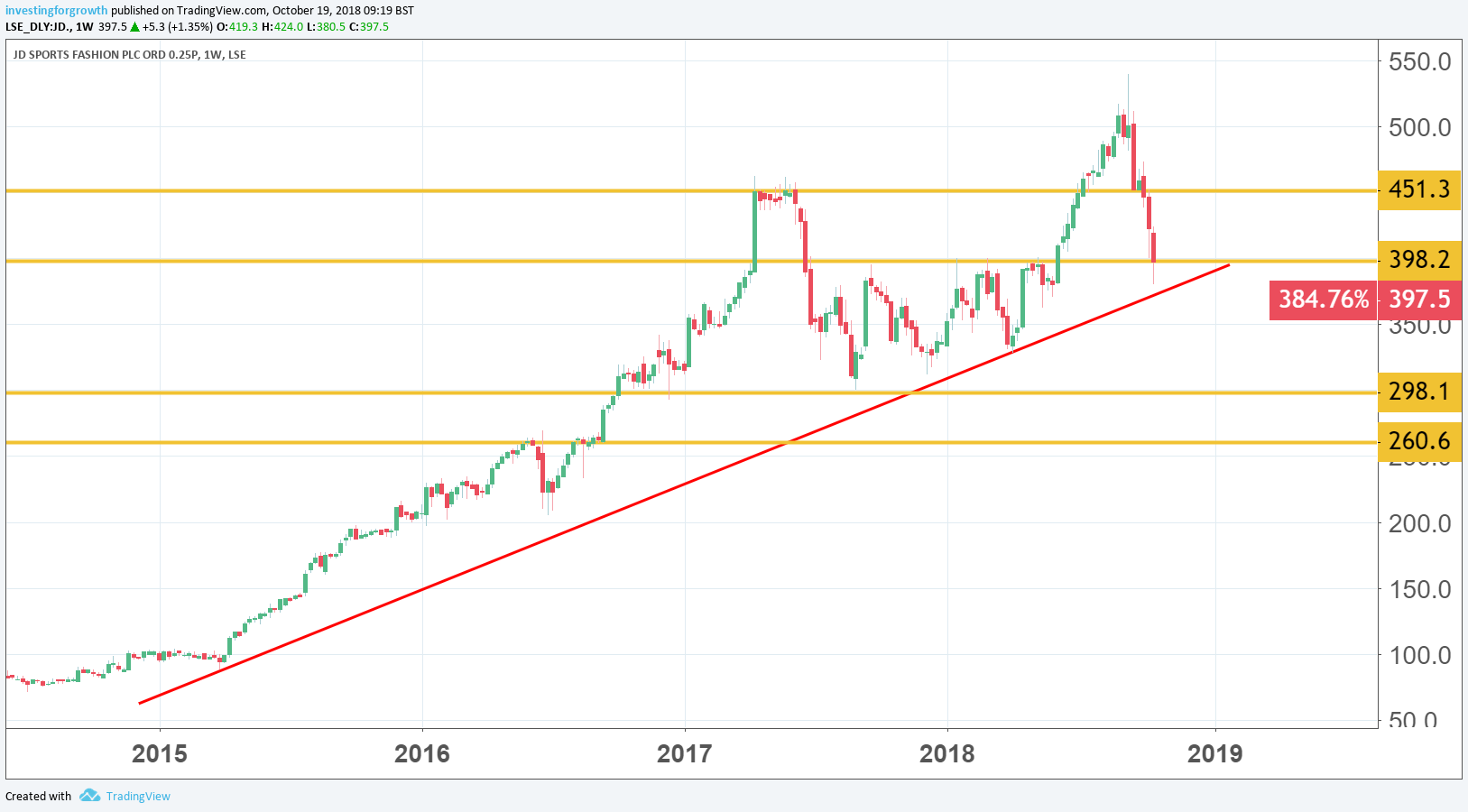Stockwatch: Is insider trading a green light to buy this winter winner?
19th October 2018 09:24
by Edmond Jackson from interactive investor
Share on
This stock typically does well at this time of year and, with the chairman already buying heavily, companies analyst Edmond Jackson checks the numbers to see if investors should follow suit.

Is a plunge in the shares of mid-cap retailer JD Sports Fashion (JD.), a healthy wiping away of froth from growth stocks, or signalling adversities?
I've addressed JD variously since drawing attention in August 2010 at a pre-stock splits equivalent of 36.2p, when its underlying earnings growth rate was not reflected in the price/earnings (PE) rating.
Back then, even on modest projections, the forward multiple was only around 7 times, although by 2012 a more typical 20 times for a growth stock had been achieved and the table shows an annual average historic PE that rose to just over 20 times in 2016 and 2017.
It has averaged 16.5 this year, which looks fair enough as regards expectations for the financial year to January 2019, but earnings are then forecast to moderate to about 9% which bumps up the PEG ratio to 1.5 (where value is typically assumed sub 1.0).
Questions over marketing and EU expansion
Looking back to my notes in April 2017, forecasts were for 2018 financial year normalised earnings per share (EPS) of 20.2p, which actually turned out as 27.3p. Indeed, last September's interim results showed 24% EPS growth with revenue up 35%.
"Retail challenges in the UK" was the excuse for 3% like-for-like sales growth, yet this week ASOS (ASC) has reported 23% UK growth, accelerating through the financial year, as if some retailers are more cutting-edge than others.
For the time being, JD's international expansion rescues its headline figures, and interims showed the UK revenue portion reducing to 58.9% of group total from 66.1%. Credit is due for this rebalancing, although ASOS and Boohoo (BOO) show sparkling UK growth remains possible. That JD is reportedly engaged in a three-way tussle for control of the cash-stricken Evans Cycles, introduces another sense of "ex-growth" regarding its core UK business.
My chief concern, as expressed in April 2017, is what Brexit impact there might be on British companies setting up on the Continent, at a time when JD is expanding rapidly there. Latest interims show European revenues at 32.6% of group total, up from 29.2%, although European revenue growth itself has soared 50.6%.
With no trade deal apparent as yet, my question 18 months ago remains apposite: "If the EU determines British exporters should be less well-off outside the single market, why should firms operating there be unscathed?" Maybe I overdo the fear, but the chairman's interim statement doesn't offer any detail how JD is contingency planning for Brexit scenarios.

Source: TradingView (*) Past performance is not a guide to future performance
A positive upshot – on a fresh money view – is stocks like this, also AIM-listed Gear4music (G4M), are liable to get hit further as Brexit realities bite. Some 90% of British fashion designers told their Council they voted Remain, and the analyst firm Retail Economics has reckoned on 11% clothing/footwear tariffs if Britain leaves the EU without a free trade agreement.
More positively, some fashion firms are setting up Continental operations specifically to avoid Brexit red tape, so it's up to JD to explain how costs/benefits could apply.
Drop is nothing unusual in short/medium-term, chart context
In common with plenty of other growth stocks mid-year, JD rallied strongly – a remarkable 44% from about 360p in June to over 520p – without any fresh news to re-appraise value.
Time will tell whether this was a "blow-off" by growth stocks, setting up a reversal that could prove a turning point (more generally) if international interest rates have bottomed out.
Growth stocks are typically favoured amid low interest rates and the extent of "normalising" rates higher could anyway be negligible in historic context. It's why US growth stocks rebounded this last week.
So there appears a macro aspect to JD's drop, if vital also to be sure the group offers robust underlying growth. Currently it's being achieved with vigorous overseas expansion – JD bought Finish Line, a US shoes and athletic gear group - hence 9.7% of interim group revenue is US-derived, "rest of world" (principally Asia Pacific) jumping 65.6% to become 5.8% of the total.
Acquisitions often raise the risk profile however, and Morgan Stanley has downgraded JD due to the Finish Line purchase, also Nike/Adidas selling directly to consumers. Management meanwhile is "increasingly optimistic about the international potential of the JD fascia."
Also, the 2017 chart saw a 50%-upwards roller-coaster – if spread out over the year - from about 300p to over 450p, then back down. Volatility is to be expected when there's negligible yield or net tangible asset backing (although a trade buyer would recognise intangible value in the JD brand), thus focusing attention on earnings that are becoming riskier in key respects.
| JD Sports Fashion - financial summary | Consensus estimates | ||||||
|---|---|---|---|---|---|---|---|
| year ended 31 Jan | 2014 | 2015 | 2016 | 2017 | 2018 | 2019 | 2020 |
| Turnover (£ million) | 1,216 | 1,522 | 1,822 | 2,379 | 3,161 | ||
| IFRS3 pre-tax profit (£m) | 76.8 | 90.5 | 132 | 238 | 294 | ||
| Normalised pre-tax profit (£m) | 95.2 | 104 | 159 | 245 | 301 | 294 | 349 |
| Operating margin (%) | 8.0 | 7.0 | 9.2 | 10.3 | 9.6 | ||
| IFRS3 earnings/share (p) | 5.8 | 7.0 | 10.0 | 18.4 | |||
| Normalised earnings/share (p) | 7.7 | 8.4 | 12.8 | 19.1 | 23.7 | 27.3 | 29.6 |
| Earnings per share growth (%) | 72.7 | 9.3 | 51.9 | 49.0 | 24.3 | 15.1 | 9.1 |
| Price/earnings multiple (x) | 17.7 | 15.3 | 14.1 | ||||
| Price/earnings-to-growth (x) | 0.7 | 1.0 | 1.5 | ||||
| Historic annual average P/E (x) | 10.6 | 16.3 | 20.3 | 20.1 | 16.5 | ||
| Cash flow/share (p) | 8.1 | 12.0 | 23.3 | 28.8 | 34.8 | ||
| Capex/share (p) | 4.9 | 6.1 | 7.8 | 8.1 | 18.9 | ||
| Dividend per share (p) | 1.3 | 4.8 | 1.4 | 1.5 | 1.6 | 1.8 | 1.9 |
| Dividend yield (%) | 0.4 | 0.5 | 0.5 | ||||
| Covered by earnings (x) | 5.8 | 6.2 | 9.0 | 12.8 | 17.5 | 15.2 | 15.7 |
| Net tangible assets per share (p) | 16.0 | 20.1 | 31.7 | 37.1 | 57.5 | ||
| Source: Company REFS | |||||||
Battle for Evans Cycles recalls the Blacks/Millets takeover
JD, Sports Direct and Halfords are reportedly in a tussle with private equity firms for Evans Cycles, the bike retailer that has racked up losses of over £8 million in the last two years. A knockdown price is the possible attraction given the current private equity owner seeks a buyer to immediately inject £10 million fresh capital.
As of 4 August, JD had £243 million cash in balance sheet context of a ratio 1.2x current assets to current liabilities, within which trade payables leapt 53% if probably acquisition-related given the way inventory doubled.
JD has past form at this: it acquired the loss-making Blacks/Millets retail chain for £20 million in early 2012, which initially contributed a £15 million annual loss and was followed at end-2016 by the £112 million acquisition of Go Outdoors (from private equity).
Yet the last interims cited mixed trading for "outdoor" businesses, blamed on weather as the severe winter boosted demand (e.g. for waterproofs/fleeces) then hot dry weather discouraged shoppers. This division had positive interim EBITDA of £2.9 million, albeit down on £6.5 million like-for-like and after depreciation/amortisation the operating loss was £3.8 million versus a £0.1 million profit.
Presumably, JD sees scope to further integrate its outdoor businesses with Evans, though a concern for the stock rating is this raising operational risks at a time of vigorous overseas expansion. There are also potential challenges regarding the EU, and from UK discretionary spending. A negative scenario is possible if such risks materialise and conflate.
Executive chairman buys £41,000 worth of shares
It's a minor purchase in context: 10,000 shares at 410p against a holding worth near £34.5 million, as if attempting to prop it up. In fairness he probably does believe in value at current prices, the question being whether company bosses are overly absorbed in operations to appreciate macro factors the stockmarket is more likely to react to. The stock has carried on down to about 390p, but is at least trying to find a level.
At around 390p, I think the broad stance is ‘hold' albeit with scope for radical variance, which is why JD is now a stock to watch. Existing holders need to be alert to the risk factors I've described, and steeled for ongoing volatility given there's no yield prop and Brexit trade talks are at a brink.
More positively, the blowing-off of mid-year exuberance implies a forward PE in the mid-teens, and international expansion – if capably managed – is still relatively early.
On a fresh money view and according to one's risk appetite, I'd be inclined to leave the stock alone, at least until there's a better sense of British retailing terms in Europe after March 2019. Buy on weakness.
*Horizontal lines on charts represent previous technical support and resistance.
Edmond Jackson is a freelance contributor and not a direct employee of interactive investor.
These articles are provided for information purposes only. Occasionally, an opinion about whether to buy or sell a specific investment may be provided by third parties. The content is not intended to be a personal recommendation to buy or sell any financial instrument or product, or to adopt any investment strategy as it is not provided based on an assessment of your investing knowledge and experience, your financial situation or your investment objectives. The value of your investments, and the income derived from them, may go down as well as up. You may not get back all the money that you invest. The investments referred to in this article may not be suitable for all investors, and if in doubt, an investor should seek advice from a qualified investment adviser.
Full performance can be found on the company or index summary page on the interactive investor website. Simply click on the company's or index name highlighted in the article.
Disclosure
We use a combination of fundamental and technical analysis in forming our view as to the valuation and prospects of an investment. Where relevant we have set out those particular matters we think are important in the above article, but further detail can be found here.
Please note that our article on this investment should not be considered to be a regular publication.
Details of all recommendations issued by ii during the previous 12-month period can be found here.
ii adheres to a strict code of conduct. Contributors may hold shares or have other interests in companies included in these portfolios, which could create a conflict of interests. Contributors intending to write about any financial instruments in which they have an interest are required to disclose such interest to ii and in the article itself. ii will at all times consider whether such interest impairs the objectivity of the recommendation.
In addition, individuals involved in the production of investment articles are subject to a personal account dealing restriction, which prevents them from placing a transaction in the specified instrument(s) for a period before and for five working days after such publication. This is to avoid personal interests conflicting with the interests of the recipients of those investment articles.